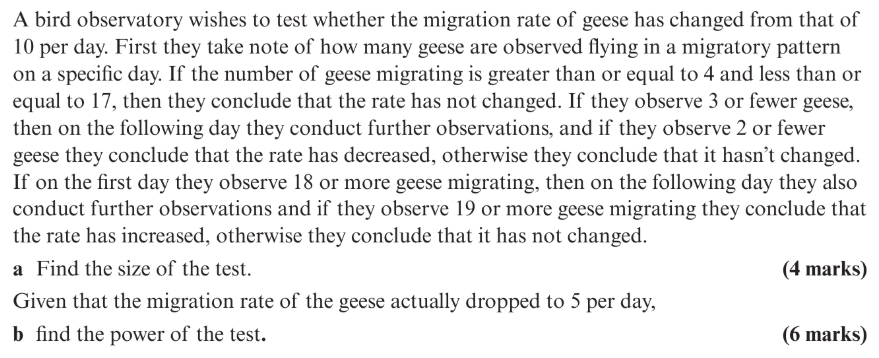A textbook of mine has online worked solutions, and the answer in the back of the book does not match the answer in the online solutions - they're not even close.
My book says that the power of a test is $1-P(\mbox{Type II Error})$, where $$P(\mbox{Type II Error}) = P(\mbox{Accept } H_0\,|\,H_0 \mbox{ is false})$$
The method that I use - and the online solutions use - is: $$P(\mbox{Accept } H_0\,|\,H_0 \mbox{ is false}) + P(\mbox{Reject } H_0\,|\,H_0 \mbox{ is false})=1$$ $$\implies P(\mbox{Type II Error}) = 1-P(\mbox{Reject } H_0\,|\,H_0 \mbox{ is false})$$ $$\implies \mbox{Power} = P(\mbox{Reject } H_0\,|\,H_0 \mbox{ is false})$$
The example in the book is as follows: Bird watchers want to test if the average birds per day has changed from $10$. If on day one, we have $4 \le X_1 \le 17$ then we conclude no change. If on day one $X_1 \le 3$ and on day two $X_2 \le 2$, then we conclude a decrease in numbers. If on day one $X_1 \ge 18$ and on day two $X_2 \ge 19$, then we conclude an increase in numbers.
I took the null hypothesis $H_0$ would be that $X_i \sim \mathrm{Po}(10)$. Assume instead that numbers have changed and that $X_i \sim \mathrm{Po}(5)$ instead. The question is to find the power of the test.
The probability $P(\mbox{Reject }H_0)=P(X_1\le 3)P(X_2 \le 2)+P(X_1\ge 18)P(X_2\ge 19)$. Assuming $X_i \sim \mbox{Po}(5)$ gives $$P(\mbox{Reject }H_0)=0.2650\cdot 0.1247+5.416\times 10^{-6} \cdot 1.402\times 10^{-6} = 0.03304$$
This is the answer in the online solutions. However, at the back of the book it says $0.3567$.
The question is a bit vague about $H_0$ and $H_1$. I think I'm treating $H_0: X_i \sim \mbox{Po}(10)$ and $H_1:X_i \sim \mbox{Po}(5)$. Perhaps I should have $H_1:X_i \sim \mbox{Po}(\lambda)$, where $\lambda \in \mathbb R_{\ge 0}$ and $\lambda \neq 10$?
Edit: Changed $\lambda \in \mathbb N$ to $\lambda \in \mathbb R_{\ge 0}$, and fixed a rounding error: $0.03303$ to $0.03304$.
Edit2: Added the following copy of the question:

